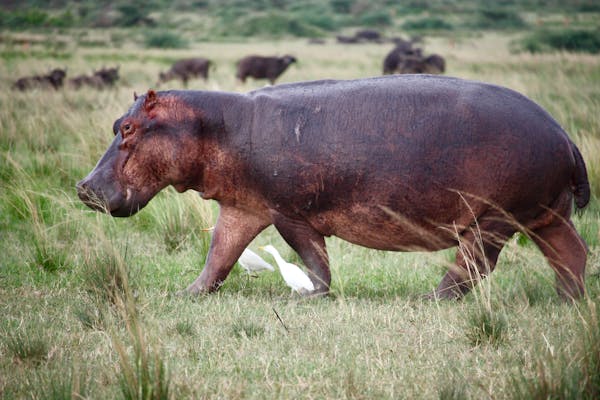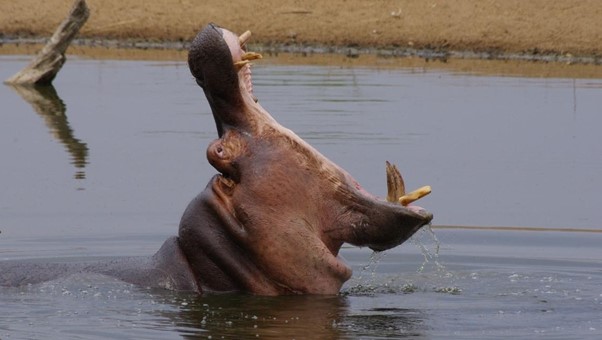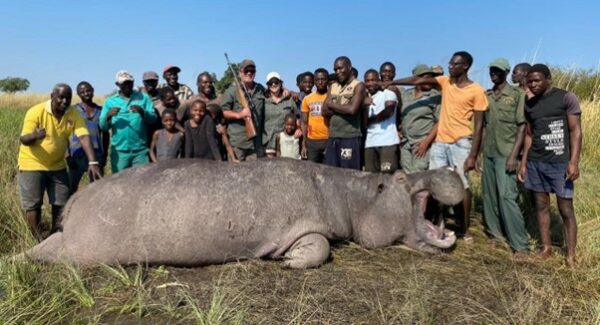The “Land Whale” may be associated with Africa’s great waterways, but hippo hunting in Namibia? Yup, it’s possible. While Namibia may be one of the most arid safari hunting landscapes on earth, it is home to a branch of the Zambezi River where hippos come home to wallow, and hunters frequent for some exceptional hippo hunts.
[DYNAMIC-BLOGTABLEOFCONTENT]
Key Takeaways
- While Namibia may be seen as the land of sand, it still has exceptional game hunting options available for semi-aquatic prey, such as the hippo and Nile crocodile.
- Formerly known as the Caprivi Strip, Namibia’s Zambezi region is the only area within the country to enjoy a hippo hunt.
- The area has rich grazing grounds, allowing hunters to top up their hunt with additional targets, such as the Nile crocodile or other big game species.
- Methods for hippo hunting in Namibia are mainly two – either on land, or in the water.
- Various shot placement options are available to the hunter, with the best option being an extremely accurate broadside shot, allowing a quick and humane death.
- Bow hunting of hippos is not allowed in Namibia.
- Hippo trophies require a CITES II permit.
- Hunting in Namibia brings about much-needed investment into the country and assists local communities with a major economic boost through job creation.
- Namibia’s hunting industry is well-managed, with quotas carefully monitored.
Hippo Hunting – Big Game Hunting the “Land Whale”
The hippopotamus (Hippopotamus amphibious) is the third largest land mammal worldwide, standing 4–5,4 feet at the shoulder, and packs an average body weight of 3,000 – 3,200 pounds. A distinguishing feature between males and females is that females typically reach their maximum size 25 years old, while males can continue growing throughout their lives, with some hippos recorded to have reached over 5,000 pounds.
Their skeleton has adapted itself to carrying this immense weight, as well as allowing them to float in the water due to a low center of gravity. A prominent hourglass–shaped head and large snout with impressive canine teeth which become weapons when needed make the hippo a very recognizable face of the wild when on a Namibia hunting safari.
Hippos are semi-aquatic and spend around 2/3 of the day in the water, emerging at dusk to graze on grasses. During the night hours, a hippo can sometimes walk up to three miles while consuming over 80 pounds of vegetation. Despite their size, a hippo can achieve a speed of around 20 mph over short distances, while travelling at around 5 mph in the water.
Hippos are known to be aggressive and have a history of charging at and attacking boats or other craft in and around their watering holes. They have also been known to access crop farms and raid the fields for food. These instances usually lead to a hippo hunt led by the farmer or community members.

Namibia’s Safari Hunting History and Contributions
Hunting in Namibia has a very similar history to many of Africa’s safari hunting destinations, it’s as old as time. The practices of trophy hunting on planned Namibia hunting safaris took off in the 60s and mainly targeted oryx, springbok, and warthog populations as they were plentiful. This practice was a big supplement to Namibia’s agricultural industry.
The big game hunting and related tourism industry in Namibia accounts for roughly 27% of Namibia’s employment while hunting conservancies contribute over $3 million to the rural communities in direct benefits from the concessions.
In many areas, these conservancies are seen as a protection against poaching, and should they be closed or hunting banned, around 50% of the jobs on mixed livestock and hunting farms would be lost as well as roughly 3,500 direct hunting-related jobs. And given Africa’s statistics on unemployment, this would be a major blow to Namibia’s economy and success.
Areas for A Hippo Hunting Safari in Namibia
Formerly (and still commonly) known as the Caprivi Strip, Namibia’s Zambezi Region is the only area in this arid landscape to cater to a hippo hunt in Namibia. The area offers opportunities for both water-based big game hunting and land-based safari hunting trips, depending on the hunter’s needs and desires.
The Zambezi Region offers hippos the ideal environment of much-needed water and rich grazing grounds, keeping them in the area and keeping them satisfied. This region is considered the “home ground” of hippo hunts in Namibia and hunting safaris in this region can easily be topped up with additional targets such as crocodiles or other big game hunting species that call the Zambezi Region home.
Methods For Hippo Hunting in Namibia
A hunting safari in Namibia typically involves the expanse of rolling desert dunes. Still, hippo hunts lends itself to both the waters of the Zambezi and the land surrounding it, giving hunters the option to choose which safari hunting environment is best suited to their skillset and abilities, as well as the type of experience they’re after.
Hunting in Water
Choosing the water environment for a hippo hunting safari in Namibia is usually the most commonplace. Hippos spend most of their day wallowing in the water which can make locating the herd or target easier, but can lead to complications in shot placement as the hippo’s exposed body area will be less.
Hunting on Land
During the daytime, hippos emerge from the water to soak up the sun, and this serves as the best time for hunting hippos on land. On land, hippo hunting in Namibia can be done with the use of a blind or through a stalking approach. Hippos also leave the water to feed during the night hours, and a bonus of this is that they always take the same path to and from the water. An easier way to track their movement if ever there was one, and a plus for shot placement as you might be able to get a bit closer to your target.

Shot Placement when Big Game Hunting for Hippo
Generally speaking, only hippo bulls may be hunted in African big game hunting destinations. A mature bull can be identified by two bumps on their snout which are made by the tusks ousting against flesh when the mouth is closed. Hippo bulls also have a thicker head and necks, but this might be less obvious in a herd setting.
Females are only permitted to be targeted on a hippo hunt during cull hunts or if given special permission.
Broadside Headshot
While the broadside typically refers to an organ shot, in the case of the hippo, it usually involves a shot to the side of the head with the hunter’s bullseye being between the eye and ear. This requires extreme accuracy as any off shot will result in a slow death, the exact opposite of any ethical safari hunting endeavor.
Back of the Head
Not the most popular or recommended of shots for a hippo hunt, this one involves the hunter’s discernment of the best point to place their shot by measuring between the ears and aiming for the middle.
Frontal Headshot
This shot placement might be the only option when wet conditions are experienced while hippo hunting in Namibia. A frontal headshot is the most ethical option when executed correctly; however, the placement can be tricky due to the size of the target area, a small triangular area between the eyes.
Shot to a Fleeing Hippo
A fleeing hippo can be compared to a wounded buffalo, they will either charge the hunter directly or take the quickest escape route, taking down anything in their path. Should the hunter be targeting a running hippo there are two options.
A shot to the spine will immobilize the animal as an accurate shot will break the spinal bone and cord. The alternative is the hip shot, which has a similar effect as the spinal shot.
Both shot placements are likely to need a succession of quick follow-up shots to secure a fast and humane death.
Heart and Lung Shot
It is best suited to taking a shot at a hippo on land as the body is exposed. A hippo’s heart sits just in front of the shoulder area with the lungs being slightly above this point. A shot like this requires a bullet designed for maximum penetration as a hippo’s skin is incredibly thick.
Neck Shot
While not an ideal first shot for a hippo hunt, it can serve as a necessary follow-up. Hippopotamuses have very thick necks which can make targeting the vertebrae challenging, especially if the hippo is in motion.

Firearms Requirements and Regulations for Hunting in Namibia
- When big game hunting in Namibia, hunters are allowed 2 firearms per hunter with a maximum of 80 rounds of ammunition per gun. The smallest caliber allowed when hunting in Namibia is .270, this is for small-game safari hunting.
- Bow hunting is legal in Namibia, however big games like hippo cannot be hunted by bow.
- Bringing in firearms for hunting safari in Namibia requires a temporary import/export permit which needs to be presented to customs when arriving.
- You will also need to supply a copy of your hunting permit as well as your letter of invitation showing the name and contact details of the farm/game area where you’ll be hunting.
- If you’re entering Namibia via South Africa, you will need to check with your airline if luggage will simply be transferred to the next flight or if you’ll need to go through South Africa’s customs. If the latter is where you find yourself, you will need to comply with South Africa’s firearms regulations as well.
Trophy Requirements and Gender Identification
Having the best trophy possible come out of your safari hunting trip means familiarizing yourself with what makes a good trophy and how to tell gender as this plays a big role when hippo hunting in Namibia.
In the Eyes of the SCI
When it comes to measuring a trophy from a hippo hunt, the SCI sets out specific guidelines for measurements.
- Only the bottom tusks may be measured and only what is exposed can be measured. Any estimations of tusk in the jaw or under the skin will not be allowed or counted.
- A tusk’s length is measured along the outside curve from base to tip. If the base or tip is broken off or jagged, it must be carded first before measuring can take place.
- The circumference of the hippo tusk must be taken at the largest point, typically where the tusk exits the gums.
- Measurements must then be totaled. If measuring in inches, round off to 1/16th of an inch, while metric measurements can be rounded off to 0.1 of a cm.
Rowland Ward Measuring System
- Trophy minimums for Rowland Ward are 24 inches or 61 cm.
- The tusk must be removed from the jaw before being measured, this is typically done when the skull is being boiled or treated. The tusk must come from its natural place in the jaw.
- Only the longest tusk may be measured. However extra notes must be made in the case of an abnormally long tusk which can result from injury or deformity to the other tusk.
- Photos must also be submitted.
- Tusks must be measured along the outside curve, base to tip from the start of the tusk to the furthest projection.
- Circumference is measured around the thickest point at a right angle to the axis of the tusk.
- Broken or jagged tusks must be carded when measuring length and in the case of circumference, the tape measure cannot sink into any cracks or divots.

Bulls vs Cows – Gender Identification when Hippo Hunting in Namibia
Hippo bulls are larger than cows and also sport thicker necks and larger heads. A smaller difference is the eyes. Hippo bulls have “flat” eyes, while cows have more “bulgy” or round eyes rimmed by pink flesh (rose-colored glasses and all that!). Bulls also tend to have ears that are jagged, torn, or cut up; these injuries result during fights for dominance and breeding.
A sneaky move hippo bulls tend to pull is that they drift to the back of the herd (in land or water) when they sense a threat or danger and need to scope it out, ensuring that they are difficult to target on a hippo hunt.
Permits and Papers for your Hippo Safari Hunting Trophy
Hippo hunting in Namibia requires no specific license.
However, hippo trophies require a CITES II permit and trophies exported to the US require a CITES export permit. Exports to the EU require a CITES II, both import and export permits, as well as an Annexure B; the same requirements go for Australia.
What Namibia Hunting Packages Bring to the Community
Namibia’s hunting and tourism industries have both grown in leaps and bounds over the years, bringing in much-needed investment. Namibian hunting packages specifically contribute more to the economy than just general tourist practices. Big game hunting in Namibia, especially in conservancies, is a major economic boost to local communities by supplying job opportunities and the chance to improve the livelihood of a whole community.
Hunting in Namibia also serves as a buffer against poaching and illegal hunting by the communities as it keeps animal populations in check, reducing the chances of crops and livestock being lost to wild animal incidences. The safari hunting industry also serves as one of the main funders of conservation programs, which have proven vital in many a big game hunting country, not just Namibia.
Frequently Asked Questions
Can I hunt hippos in Namibia?
Yes, hippos are hunted in Nambia, in the region formerly known as the Caprivi Strip, now referred to as the Zambezi Region. Hippos are hunted on the banks and waterways of the Zambezi River.
Where can I hunt hippos?
Apart from hippo hunts in Namibia, hippos can also be hunted in many African countries, including South Africa, Zambia, Zimbabwe, Mozambique, and Tanzania.
Is Namibia good for hunting?
Namibia remains a prime game hunting destination, offering a range of species from the Big 5 and Dangerous 7 to African plains game and specialty species.\
Where should I shoot a hippo?
Circumstances of the hunt will dictate the shot and angle, but shot placement will need to be exact, to ensure a quick and humane kill. Popular options include a brain shot, which again, needs to be precisely on target.
Where can I hunt in Namibia?
Your hunting region in Namibia will all depend upon the target that you want to hunt. When hippo hunting in Namibia, the Zambezi region (formerly known as the Caprivi Strip) is the country’s hippo hunting ground.
Namibia’s Big Game Hunting Industry
- Hunting in Namibia is officially permitted between 1 February and 30 November.
- The times for a hunting safari in Namibia are stipulated as half an hour before sunrise to half an hour after sunset.
- Hunting at night, with artificial light, or with dogs is illegal.
- Namibia hunting packages are run according to fair–chase practices.
- Female animals that have a dependent calf or young may not be hunted.
- Vehicles may be used to reach the big game hunting destination, but no hunting may take place from a vehicle.
- Mandated lengths for hunting safari may be set by the outfitter, but these aren’t regulated by the government.
- Quotas for animals on privately owned farms are set by the owner, while government conservancies and concessions are under the Ministry of Environment and Tourism.
Hippo hunting in Namibia provides hunters with not only an exciting game hunting adventure but the chance to make a difference in the lives of local community members. That satisfaction, together with the opportunity to lay claim to one of the most notorious members of the Dangerous 7, is just what a hunter needs at the end of the day!
If you enjoyed reading this article, read more about Hippo Hunting Adventures in Namibia’s Caprivi Strip.
Author: A. Baker
